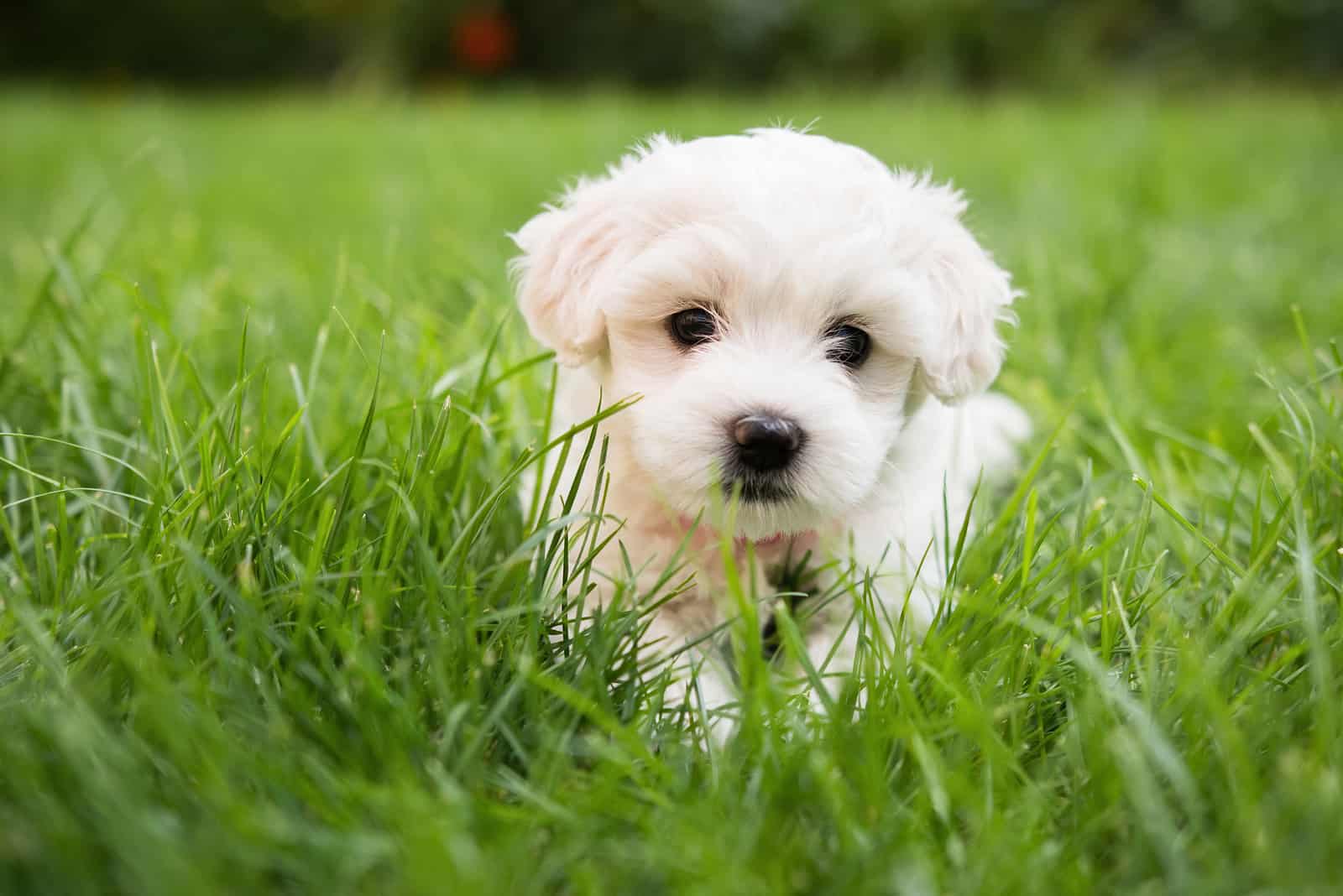How many times have you heard about Maltese dogs in different colors? Has anyone ever tried to convince you that a black puppy can be purebred like a white one?
It’s time to discover everything about Maltese colors, what kinds of Maltese are there, and whether their colors have any impact on their temperament and overall health.
White-colored Maltese dogs are dominant, but some specific shades are approved under certain conditions by the greatest kennel clubs and organizations.
Maltese dogs have been known for thousands of years, and were primarily used as “comforters”; dogs that were ladies’ best friends in the past (and have remained so nowadays as well).
The primary purpose of this article is to help you make a difference between a mixed and a purebred Maltese canine, and give you some helpful information about these dogs in general, including their mixed breeds.
Official Maltese Colors
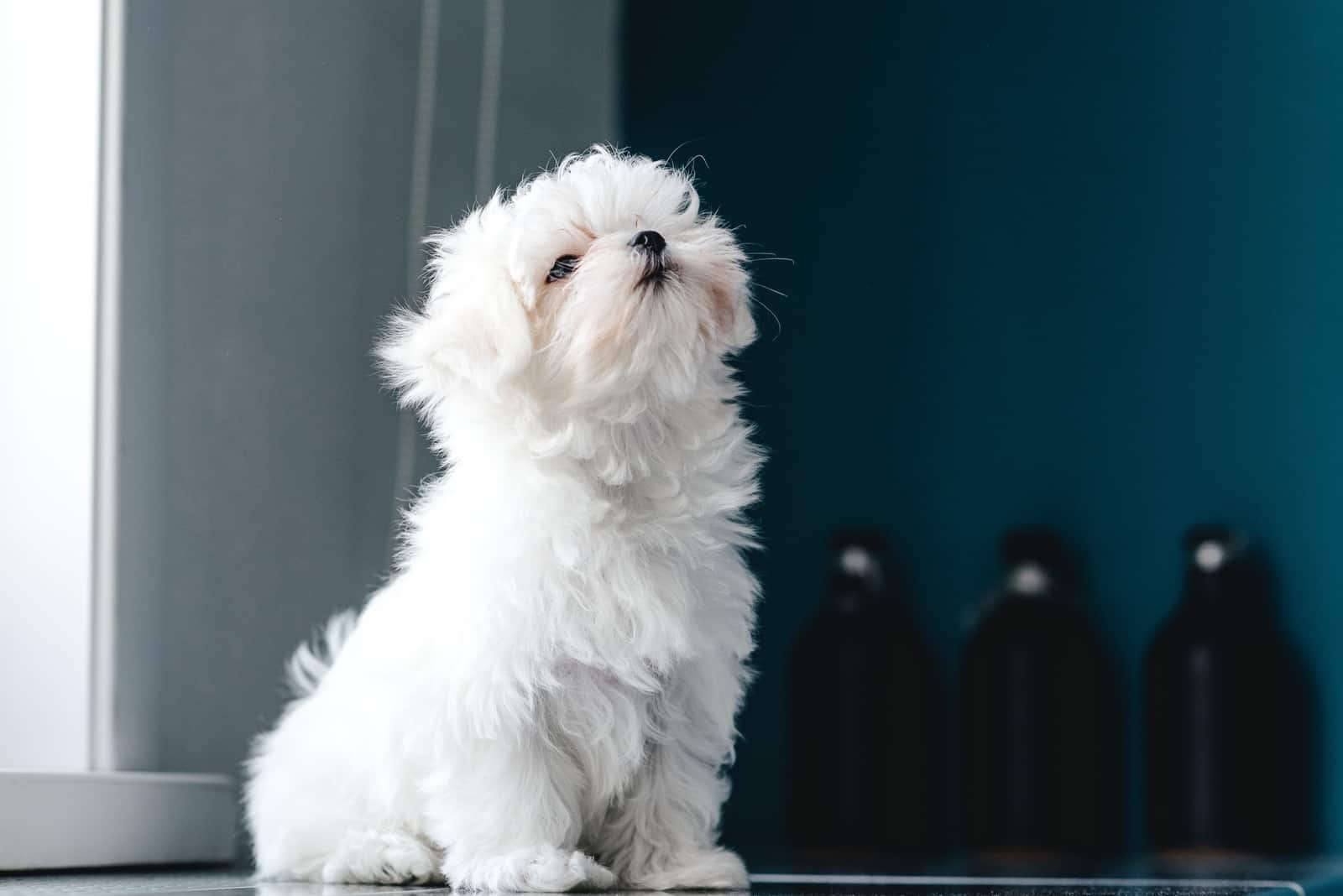
Maltese dogs are considered a pure white breed that doesn’t have a variety of different colors like Poodles and other dog breeds.
However, the American Kennel Club (AKC) does approve of three specific colors: white, white and lemon, and white and light tan.
It’s interesting to notice that pure white is still considered the only standard shade of this breed, which is why it’s marked as “S”, while the other two are recognized, but only with the “A” marking, which stands for alternate.
If you’re interested in markings, here’s a list of all labeled acceptable colors in the Maltese dog breed according to the AKC:
• White (S199)
• White and lemon (A211)
• White and tan (A217)
• White with black marking (S019)
As you may notice, there’s an additional code S019 at the end of this list, and no, this isn’t a mistake.
The S019 also stands for a solid white Maltese, but with specific markings that might appear as a black nose, lips, eye rims, or paw pads.
According to the AKC standards and dog competitions and shows, this is the only accepted marking.
However, the Federation Cynologique Internationale (FCI) is a bit more flexible when it comes to the colors of purebred Maltese dogs, so they accept pale ivory beside the pure white color.
Pale orange is another shade acknowledged by the FCI, although these dogs won’t be graded the same as cream or pure white Maltese puppies.
Other Colors Of Maltese Dogs
Eye color
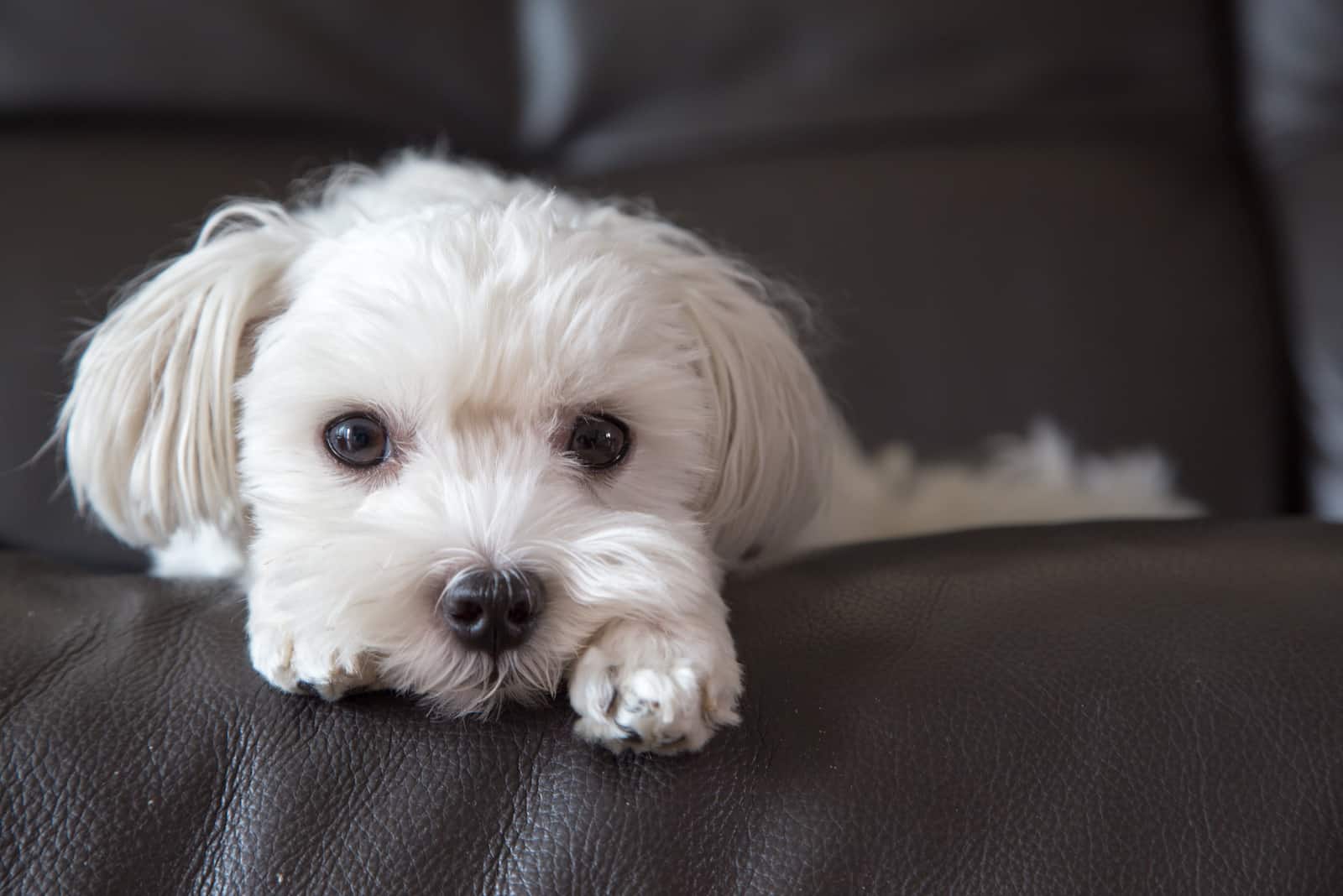
This dog breed is popular for its big, dark eyes that can be either completely black or a tiny bit of the darkest brown.
It’s easier to find a purebred black Maltese (which is impossible) than a purebred Maltese with blue or green eyes.
This breed might be blue-eyed in two cases only. The first one is that it’s not a purebred canine, and the other possibility is that the pup has a particular genetic deviation.
Remember… almost every Maltese pup has blue eyes after birth, but this color turns black after the first few weeks of its life.
Belly color
The Maltese dog has darker skin on the belly, which sounds quite surprising as Maltese dogs don’t spend too much time on their back during sunlight.
However, there’s no need to lay on the back in order to get a different color on the belly. It’s possible to change shade just from the sunlight that casts back off the ground.
Brown, gray, and black spots might appear on the belly as the result of exposure to sun rays. These spots don’t always look the same. During winter, the pigment might fade, but it can also become darker in spring and summer.
Some dog owners might not be thrilled with these changes, and prefer the skin to be up to the breed standards. There are certain ways to fade those marks, but if you notice that the colored marks still increase, you should immediately contact the vet.
Make sure to check these marks regularly and react in time if you notice any unusual change.
Nail color
This might not seem like one of the things dog owners think about, but it might be pretty important info for breeders and owners who take their dogs to dog shows.
The AKC is very flexible with this one, and states that all nail shades are acceptable.
However, the FCI has a slightly different opinion about this topic. According to them, black and dark shades are the acceptable options for standard Maltese doggies.
Most Maltese canines have dark nail shades, although there are rare exceptions with light tan or ivory-colored nails.
Maltese Color Changes

I’m sure you already remember that purebred Maltese have exclusively white hair with only a few acceptable shades.
A significant number of Maltese owners notice certain discolorations at some point in their pet’s life. This toy breed often has creamy or lemon spots on the coat, increasing as the doggie gets older.
These spots are generally misinterpreted as genetic changes or permanent markings that can’t be removed by any means, although they can, but only by following specific steps.
There are partial and complete discolorations of the coat. The paws and chin are the most common places that change colors into a yellowish or an ivory shade. These changes are generally the results of dirt, saliva, and other external elements that have an impact on the dog’s coat.
Most owners claim they actually couldn’t notice the gradual change of color, and were surprised once they compared their pet’s old photos with how they look today.
Still, if you’re not pleased with the color combination of your dog’s coat, you might want to follow the steps that will bring back that solid white color to your pup’s coat.
How do you restore an old coat color?
High-quality shampoo
Make sure to choose a shampoo that won’t color the coat hair, but has the ability to wash the markings off the dog’s hair.
Shampoos with color enhancers will be perfect for washing out coat stains.
Use wipes
There are plenty of great grooming wipes that can wipe out all the dirt and bodily fluids that might change the color (urine, debris, sand, etc.)
Use these wipes for everyday cleaning of your pet before baths, and it’ll keep its snowy white color for the rest of its life.
Avoid tap water
This might be one of the mistakes that the majority of dog owners commit without knowing the possible consequences of such actions.
If you want to improve your dog’s health and bring back that beautiful white pigment, avoid tap water that doesn’t get filtered at all.
The toxins and minerals from this type of water are among the most common causes of coat color changes.
Color changes around the eyes and nose
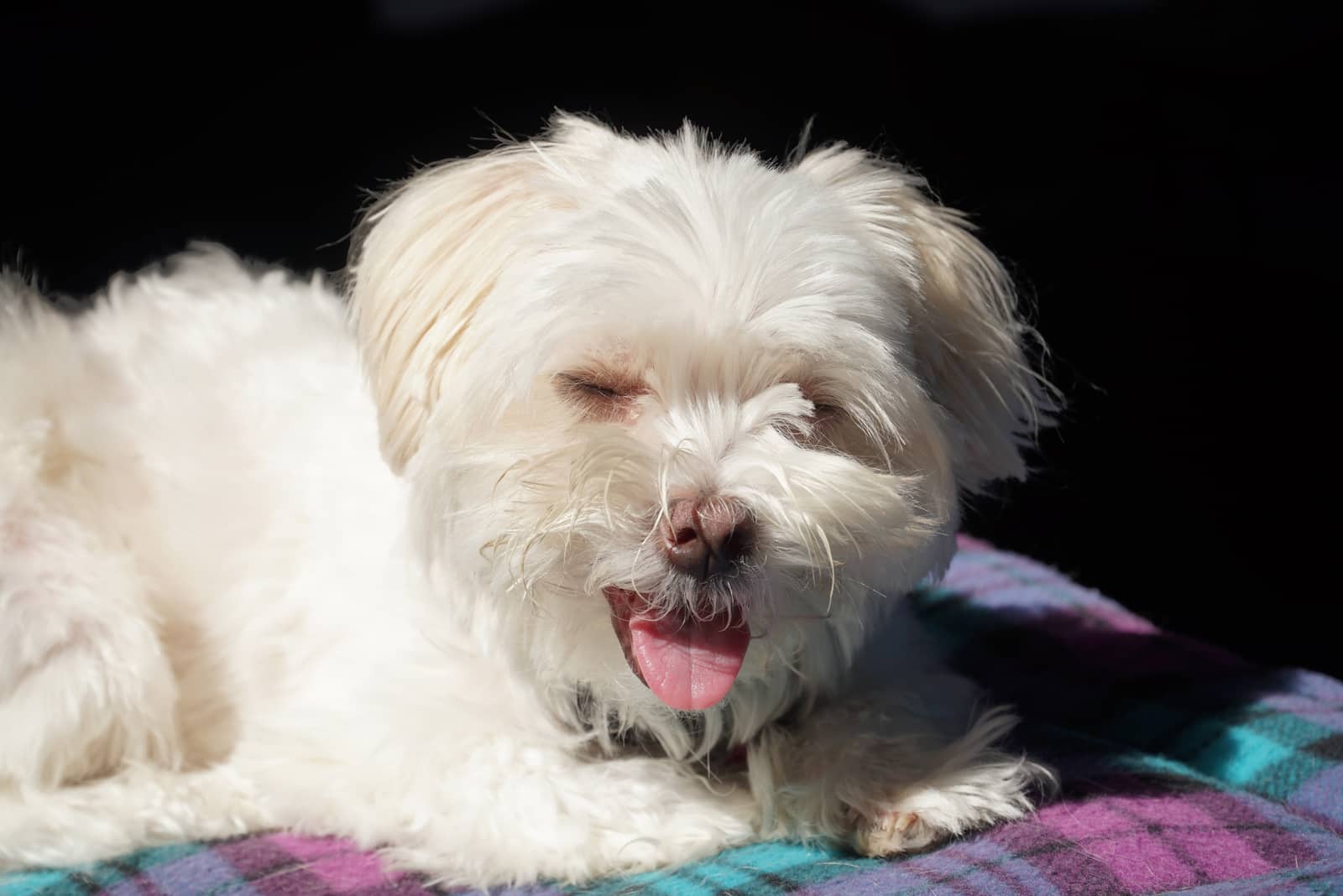
White-coated canines like the Shih Tzu, the Maltese, the Samoyed, and others are very sensitive to any possible stain that might appear on their coat, including their eyes and nose.
Eyes
Brown, red, or rust are the most common shades that can be found around the eye area, which are, in most cases, results of tear staining.
If you wish to change the color back to white, you can get a good tear stain remover.
The tear stain remover is the best option if you want to change the color around the eyes back to white, as it should be.
Nose
Although it’s a rare occurrence, there are Maltese pooches with a nose in colors other than black. This might happen because of genetics or external factors.
The gene that’s in charge of coat discoloration is named the parti gene. This particular gene might also affect your puppy and change the color of the nose to lighter versions.
Nose color may also change because of external factors, including the environment where they’re bred. Unfortunately, this type of change is usually beyond repair.
Maltese Mixes

This small-sized dog is often mixed with a variety of other dog breeds in order to get new dog types and colors.
Is there a black Maltese?
As it was mentioned earlier, it’s impossible to find a purebred black Maltese. However, there are certain mixes that produce black pups as well.
For instance, if you mix a Maltese with a Pomeranian, there are high chances that the puppy will receive black color from the Pomeranian part.
What about a brown Maltese?
Just like black mixed breed pups, brown Maltese are also a mix of this small breed and other types of dogs.
Brown pups are typical results of crossbreeding between teacup breeds such as a Maltese and a Pomeranian, a Toy Poodle, or a Shih Tzu.
Albino Maltese
Albino Maltese pups are a sporadic occurrence, but they do appear. Albinism is essentially a lack of melanin and pigment, which results in a pure white coat of hair and dark spots turned into pink color.
Unfortunately, Albino Maltese pups aren’t recognized as the standard breed, which is why they’re not allowed to compete in dog shows.
Once again, purebred Maltese canines are always white, with possible spotting of creamy or lemon-like colors. If anyone tries to persuade you to get a purebred Maltese of any other color, it’s just a trick of an untrustworthy breeder.
Mixed breeds are generally in good health mainly because they got the best of both parents. However, particular health problems might be the result of crossbreeding.
This is why it’s essential to check the bloodline and heritage of each puppy.
Barbichon types of dogs

Photo from: @maltese_breeds
At least once, I’m sure you came across a dog breed very similar to the Maltese, although you could recognize it was not the same breed.
The Maltese dog breed is a part of the big family named Barbichon canines. These types of canines are connected through the same place of origin (the Mediterranean) and similar physical characteristics that might cause confusion between the breeds.
A lot of people mix Maltese with Bichon Frise or Bolognese, although they all belong to different breeds.
Here are the relatives of Maltese canines that are often considered their siblings:
• Coton De Tulear – A pure white canine that might have darker hair around the ears.
• Bichon Frise – A white-colored doggie that might contain light orange or cream colorations. However, the AKC only recognizes this type of dog if the discoloration is under 10%. Everything above is treated as a fault.
• Bolonka – This is a Russian breed that is very rare. Bolonka hardly survived the cold war, after which these dogs were on the verge of extinction. They usually come in gray, brown, red, and black shades.
• Havanese – These adorable pups come in different colors, including chocolate, gold, black, red, white, cream, and silver.
• Bolognese – Another white canine with a possible slight cream shade that resembles Maltese dogs quite a lot.
• Maltese – Exclusively purebred white pups that have only slight discolorations.
What Is A Silky Cocker?
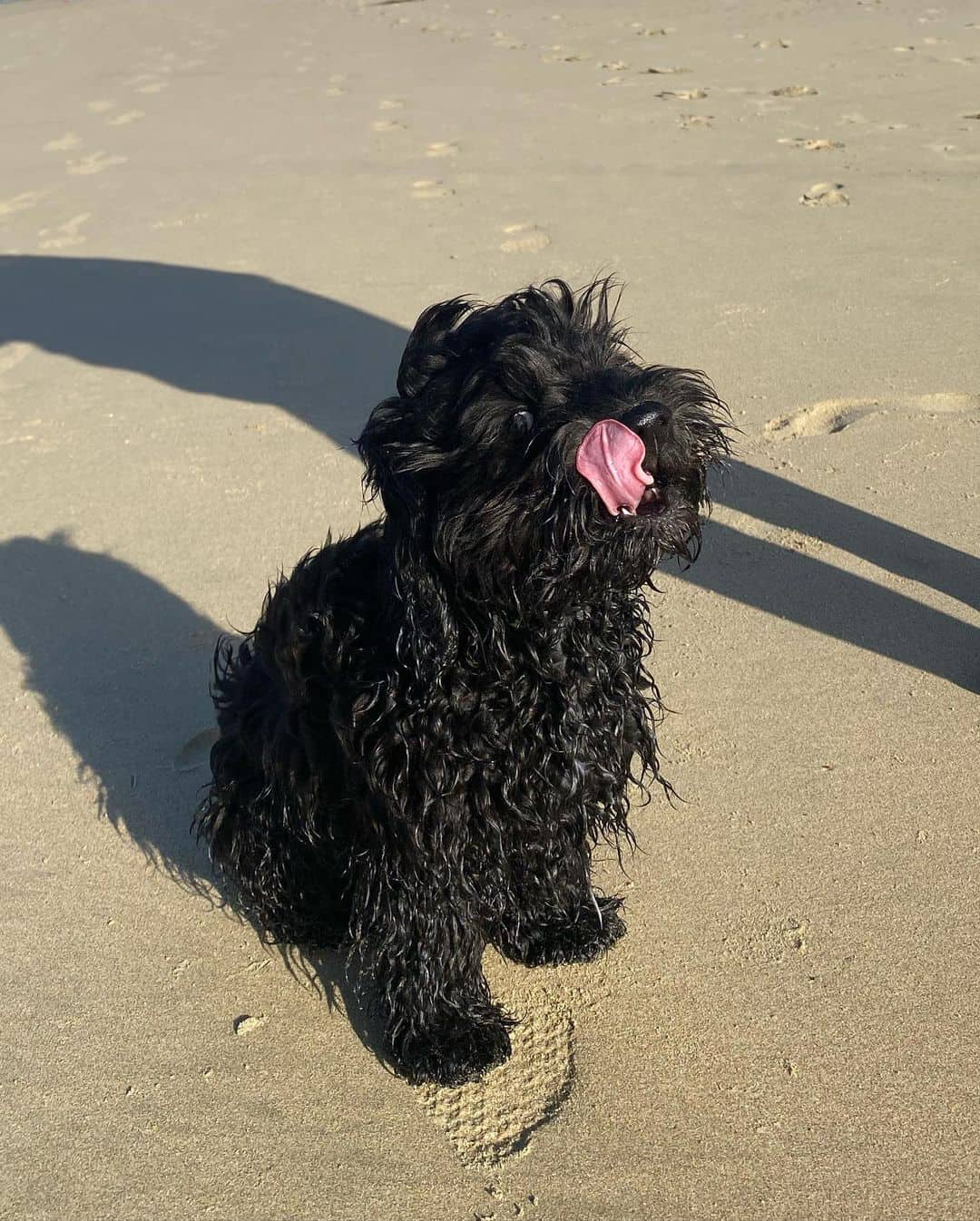
Photo from: @morristhesilkycocker
This dog type with an interesting name is a result of crossbreeding between a Maltese canine and an American Cocker Spaniel.
These two small-sized breeds are the parents of an equally miniature hybrid canine that can grow up to 14 inches.
As the name says, the coat of this breed is as soft as silk, and the hair can be either straight or wavy.
A Maltese and its hybrid version look very similar, although they differ in the variety of colors that Maltese Spaniels inherited from the other breed.
Therefore, Silky Cockers can be found in black, brown, hazel, cream, beige, ivory, and all other colors from that range.
When it comes to shedding, this mixed breed dog is a true mix of its parents. While Maltese don’t shed a lot because they don’t possess the undercoat (which is why they’re hypoallergenic), Cocker Spaniels will leave furry traces all around the house during every season.
However, the Silky Cocker’s coat stands somewhere in the middle as a medium shedder.
The Origin Of Maltese
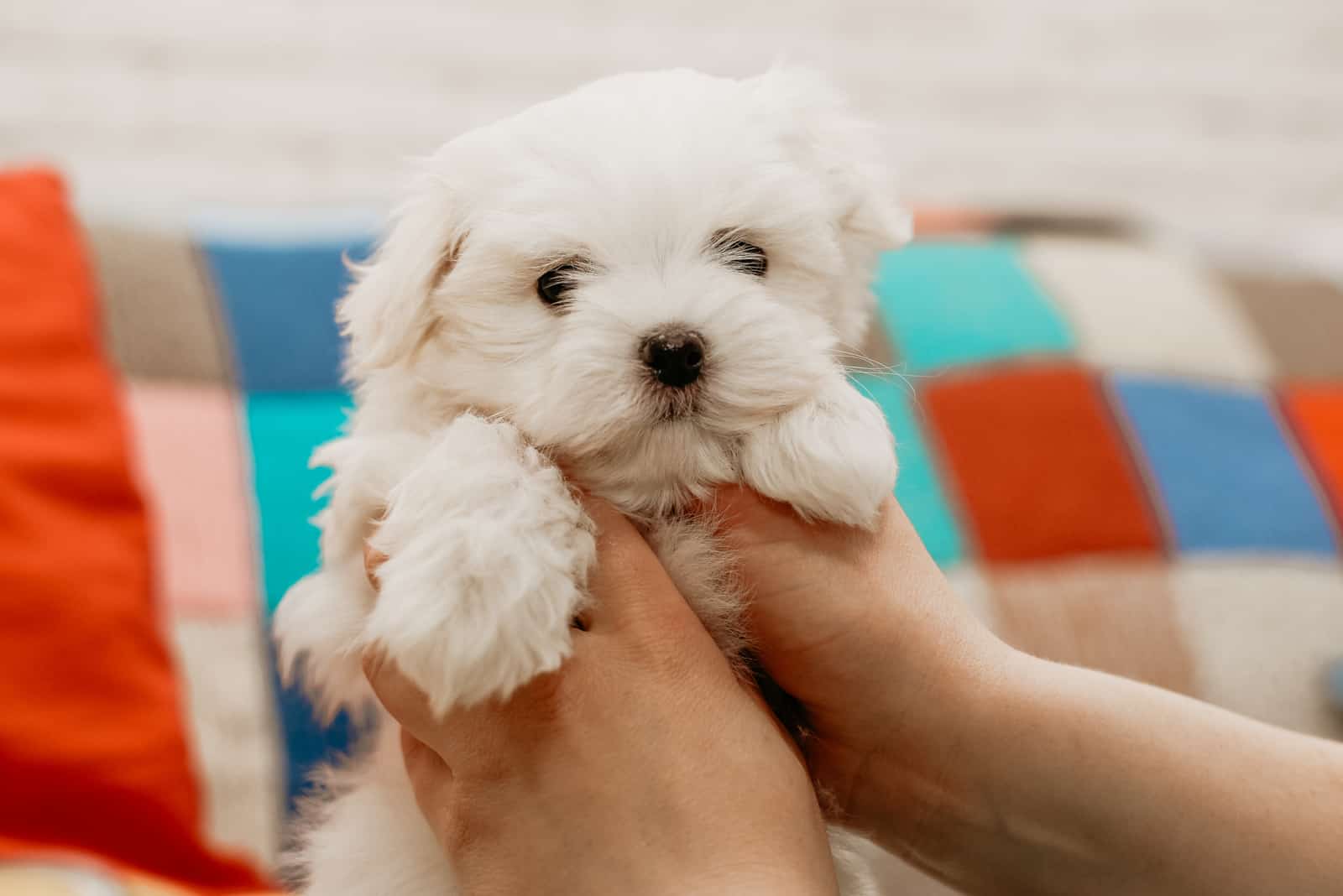
Maltese dogs are pretty antique, to be honest. The traces of their ancestors are older than 8000 years, although modern Maltese look nothing like their ancient versions.
Most experts claim this dog breed originates from Malta. However, there’s still some confusion about the exact origin as others connect the Maltese to places like Sicily and southern Europe in general.
However, everyone agrees that this breed had evolved in Malta before it was spread around the world.
It’s believed that Phoenicians brought these doggies with them when they colonized the island, today known as the Republic of Malta.
Phoenicians were known as traders and sailors, so it’s no surprise that the Maltese was found in different parts of the world.
What was the main purpose of Maltese dogs?
Their main duty was to comfort and accompany (mostly) ladies every time they went out for a breath of fresh air.
It didn’t take long before these little white dogs became popular as furry friends. The United Kingdom acknowledged this breed as pets and showed the dogs during the 19th century, making them one of the first dogs that participated in shows and competitions in the UK.
To be honest, these dogs were never bred to become working or hunting dogs, like German Shepherds or Border Collies.
Maltese are popular pets nowadays, especially among families with older children who know how to take care of a small dog.
The introduction of colors.
Maltese are famous for their snowy white color, but that’s not the only coat color at all.
This dog breed has evolved throughout history, and has undergone many changes, including new dog types that are the result of crossbreeding.
In 1877, this breed was one of the main attractions in Westminster. However, this type of dog was known under another name: “Maltese Lion Dogs.”
Two years later, the same breed reappeared in Westminster, but the Maltese had a white coat and black ears, and a new name! This was the first time the Maltese Skye Terrier was mentioned as a type of Maltese canine.
This may have been an inspiration for the Kennel Club of the United Kingdom (KC) to let Maltese of all colors participate in dog shows. Unfortunately, that only lasted from 1902 to 1913.
This raised the interest for Maltese pups in the United States as well, but the U.S. breeders had requests for specific changes that could be made by mixing breeds.
The main point of crossbreeding was to reduce the Maltese in size because the dogs shown in the UK were more than 10 lb, along with bringing back the pure white shade without any discoloration.
Many trials and errors included the Pomeranian Maltese mix that resulted in black pups, and the most popular mix with Poodles, which was later named the Maltipoo.
Maltese pups weren’t as popular in the past as they are today. At the beginning of the 1900s, there were around six Malteses acknowledged by the American Kennel Club (AKC). This number increased by the 1950s to 50.
Nowadays, Maltese has developed into snowy white canines, although there might be certain shades that are relics of their past.
Maltese Dogs: General Information
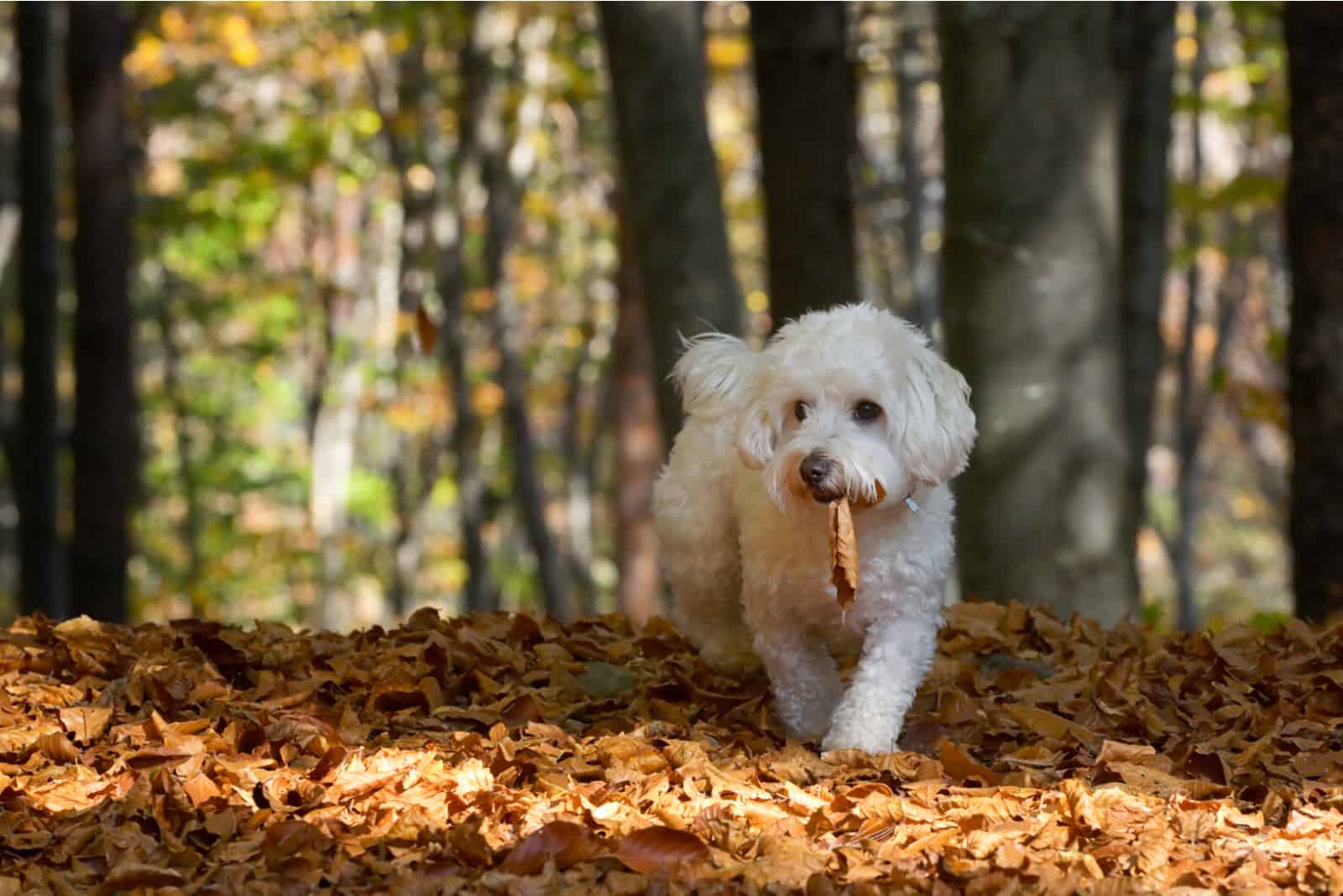
Dealing with kids.
Maltese can create an incredible bond with kids simply because they both like attention and cuddling.
However, although they’re good with children, Maltese puppies may not be the best choice for toddlers because they’re very delicate and small dogs.
But, don’t let their size fool you. These dogs are firmly attached to their families and will protect them from any potential danger.
They might be delicate, but Maltese also know how to defend. However, they should still be handled with great care, which is why they’re great pets for families with older kids.
Health Issues
There’s no dog breed without any particular health issue, although most types of dogs share common health problems such as eye issues, cardiovascular conditions, problems with joints, etc.
Below, you can find some of the most common health conditions that appear in Maltese dogs. Some pooches might have additional issues as well, but they’re not as common as the ones that are listed here.
To be clear, not every Maltese suffers from these illnesses, but they might have a greater risk of developing specific conditions than other breeds.
Heart illnesses
Unfortunately, this is one of the most frequent diseases among Maltese canines. To be specific, this breed has a higher risk of Mitral Valve Disease (MVD) and Patent Ductus Arteriosus (PMD) than other dog types.
PMD is a congenital condition that appears at birth when the ductus arteriosus doesn’t close completely, which causes blood flow into the lungs. This heart issue can cause heart failure and other health issues related to cardiovascular diseases.
MVD is a common cause of heart murmur because of the excessive blood that comes back into the left atrium. This happens when the gate leaks blood back instead of pushing it through only one way. It can be a serious issue that might result in Congestive Heart Failure (CHF).
Eye problems
This dog breed may develop specific eye issues, which include tear duct issues, Albinism (PRA), corneal ulcers, glaucoma, and problems with eyelashes.
There’s a variety of issues that might affect the dog’s vision, but one of the most common reasons for eye issues is long hair.
Long hairs frequently end up in a Maltese’ eyes and irritate them. The best way to solve this issue is to regularly groom your pet and decrease any chance of eye issues, including tear staining resulting from uncontrolled tear letdown.
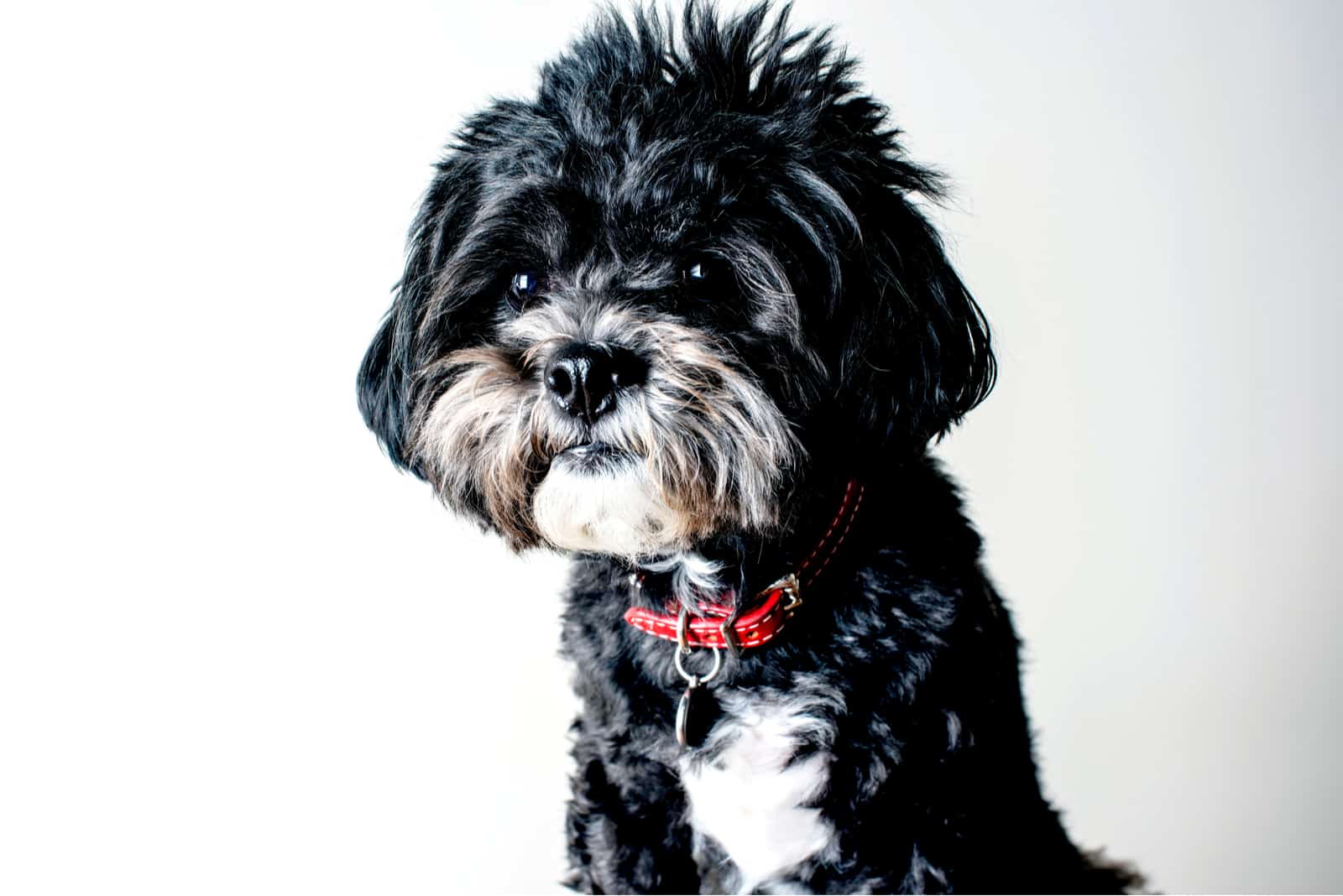
Ear infections
Floppy ears are one of the leading causes of ear infections among Maltese canines.
Essentially, all the yeast, bacteria, and other bad stuff stay trapped in the ears because the outer ear shell covers the inner part of the ear.
Good hygiene and regular vet visits will ensure good health and great hearing for your pet.
Hypothyroidism
Hypothyroidism is a disease that is quite common in this dog breed.
Unfortunately, more than 22% of these canines develop this issue during their lifetime.
This percentage placed them in the ninth position (out of 140) on the list of the Thyroid Database of Michigan State University.
The main symptoms that might suggest that your dog is suffering from this illness are:
• Dark pigments on the skin
• Sudden weight gain
• Dullness
• Thinner coat
• Lower energy level
If you notice any of these signs, it’s time to call the vet. There’s no need to fear – the vet can discover hypothyroidism through blood analysis, and with the right therapy, your dog can continue living its best life.
Luxating Patella
This is one of the most frequent health issues among toy dogs, including Maltese canines.
Luxating Patella is essentially dislocation of the knee – the knee cap falls out of the trochlea (the groove where the kneecap is positioned).
This is easy to notice – as soon as your dog starts skipping or hopping to avoid standing on its back legs, you can assume what’s going on.
Luxating Patella is generally not an overly severe health issue, and can be treated with medication. However, if the situation worsens, the kneecap might be fixed by surgery.
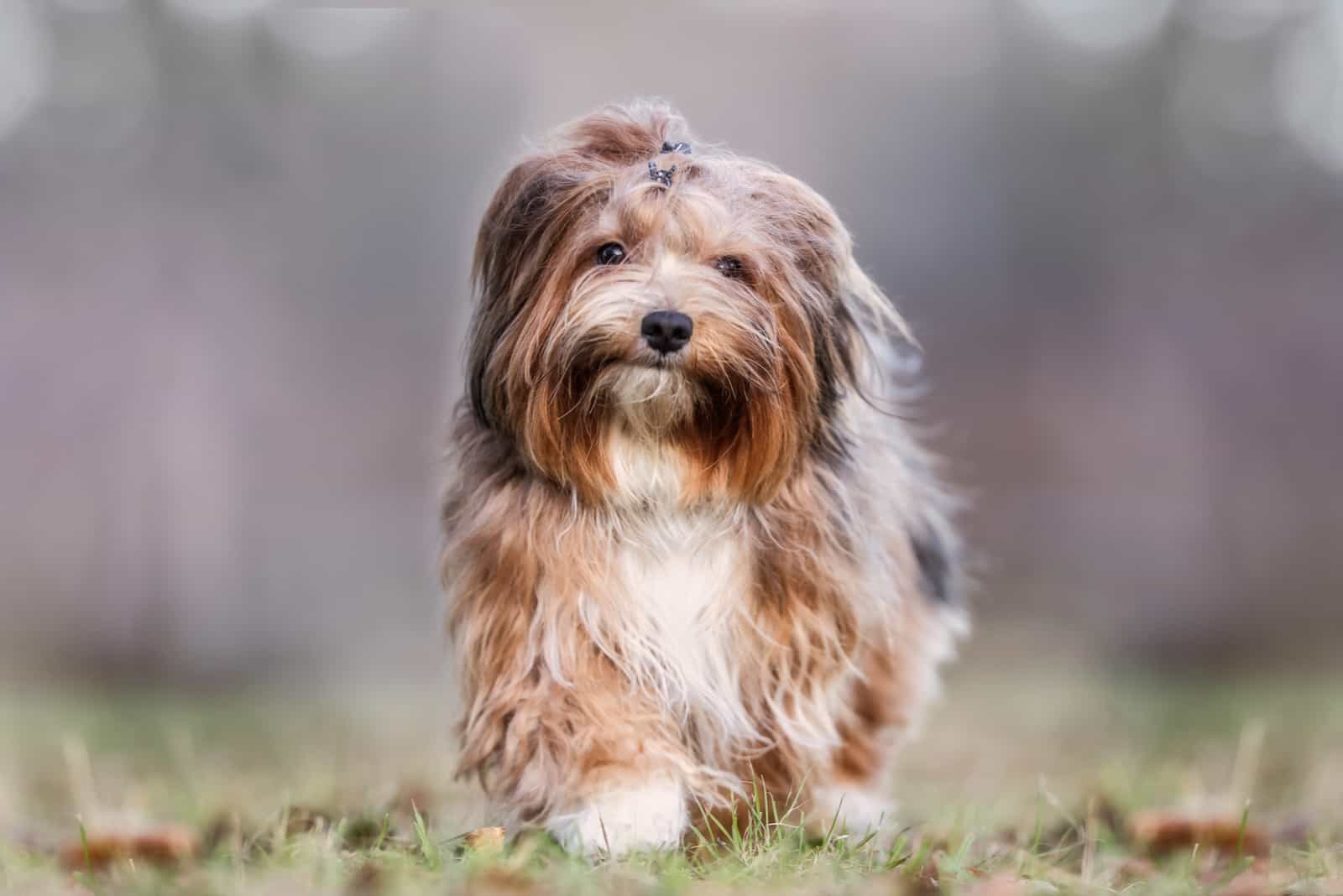
Dental issues
This is no news for dog owners in general, not just those who own a Maltese. A large number of canines have dental issues, and unfortunately, it’s a chronic issue that affects the majority of pooches.
Both female and male Maltese are equally affected by teeth issues. The first signs of teeth problems are a build-up that constantly shows up on a dog’s teeth, which later turns into a gum infection.
Losing teeth is the least of the problems that await dogs whose owners don’t react in time. Sadly, dental issues might cause many serious diseases like:
• Kidney disease
• Heart problems
• Liver issues
• Problems with joints
One of the things that most people ignore is the fact that dental problems might have a negative impact on a canine’s lifespan as well! Your dog’s life might be shorter by one to three years depending on its overall health.
The best way to prevent these health problems is by regularly taking care of your dog’s teeth. If you brush your pet’s teeth every day, you’ll significantly decrease the risk of your dog getting any of the diseases mentioned above.
Separation Anxiety
Maltese dogs are very attached to their owners and the family they belong to. They’re used to a lot of attention, cuddling, and emotional support.
They’re not very fond of any type of change, including daily habits, new members of the family, or anything else that might have an impact on their daily schedule.
Maltese don’t like to stay alone at all. If they spend less time with their owners or other dogs, they immediately become stressed, which leads to separation anxiety.
Other causes of separation anxiety are:
• Strict discipline
• Less outdoor time
• Moving to a new place
• A loud environment
• An owner who’s under a lot of stress or suffers from anxiety
This type of stress can have a negative impact on a Maltese’s quality of life, including its life span and other health issues (certain skin disorders, infections, etc.)
A Maltese requires a lot of attention, and if you provide it with a lot of love and a safe environment, you’ll have the perfect pet!
Training
Maltese are adorable pets, there’s no doubt about that, but they’re not very easy to train, although they’re loyal and affectionate towards their owners.
House training might be overwhelming from time to time, but you need to have a complete understanding of your little pup. That’s why a lot of experts recommend crate training that’ll serve as a safe place during the initial period of habituation.
Final Thoughts
I hope you’ve enjoyed reading this article and discovering fascinating facts about Maltese colors.
If you see a Maltese dog in any color other than solid white, cream, or light lemon, you’ll know it’s not a purebred canine.
Of course, people who are looking for a house pet won’t mind the color and the bloodline as much as those who want to display dogs in competitions and shows, or breed them.
Mixed breed pups can offer the same amount of love, just like those that are purebred. The color doesn’t affect the dog’s temperament or its traits, which is why “regular” dog owners don’t mind having a black Maltese after all.
However, it’s important to remember that purebred and crossbred canines can develop specific health issues, which is why you need to observe your pet and react if you notice any unusual change or possible symptom of a disease related to Maltese dogs.
This article has shown that Maltese canines have a rich history, a great present, and a wonderful future, especially with caring owners who are eager to please their pets.
This ancient breed will provide you with fierce loyalty and a significant amount of comfort in any life situation because that’s what their primary purpose was for the last few centuries.
I hope you can see that there’s no particular reason to judge a book by its cover – better to say, judge a Maltese by its coat.
If you like a certain puppy and you’re not planning to breed it or take it to dog shows, then just go for it… be it a Merkie or any other type of mixed breed doggie!
Good luck with your new puppy whichever you decide upon. I’m sure every dog would be happy to have you as its owner!
